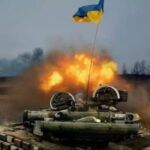US President Joe Biden met NATO Secretary General Jens Stoltenberg at the White House and confirmed, that the Alliance is united in defending Ukraine for as long as it takes to fight Russian forces. However, neither the US president, nor the Alliance secretary general even hinted at who might lead NATO after the departure of Stoltenberg, who is determined to leave the post at the end of 2023.
The meeting took place about a month before the annual NATO summit to be held in Vilnius. Before speaking to Biden, Stoltenberg, together with US Secretary of State Anthony Blinken, announced a “robust” new defence and political assistance package for Ukraine, which will be unveiled at the summit in Lithuania.
It is a $325 million tranche, that includes additional ammunition for high-mobility artillery rocket systems, anti-tank weapons, armoured vehicles, artillery shells and other equipment. “The United States is working with more, than 50 countries to join forces to support Ukraine’s self-defence against Russian aggression,” the secretary-general said.
Speaking to the US president, Stoltenberg said – Ukrainian forces were “making progress” in their just-started counter-offensive. “The more land the Ukrainians can liberate, the stronger their hand will be at the negotiating table,” he said confidently.
Stoltenberg stressed, that Russia’s 16-month war had been a struggle “against free people everywhere”, arguing, that the consequences of any victory by Moscow would be that the world would become “more dangerous”.
According to Stoltenberg, the Alliance “agrees to support and strengthen support for Ukraine”, which includes a “firm commitment to increasing defence spending”. And Biden, for his part, said Russia’s unleashed war against Ukraine was now one of the biggest challenges for the US and said it was important to provide aid to Kiev.
“Because if we don’t, imagine what will happen. Think about it,” the president said.
These statements obscured the disagreements, that now exist within NATO over the pace and nature of defence assistance to Ukraine, its request for security assurances from Russia and its application for NATO membership. And they have also distracted from the question of Stoltenberg’s possible successor.
European capitals are eagerly awaiting a signal from the White House as to who Joe Biden will support for this job. Known to be slow and unhurried in his decision-making, the US president is now taking his time as well. Last week he met with Danish Prime Minister Mette Frederiksen, whom many European diplomats consider to be on the shortlist of potential candidates, and with British Prime Minister Rishi Sunak. Sunak is prototyping British Defence Secretary Ben Wallace for the post of Alliance general secretary.
Stoltenberg, who has led NATO for nine years after extending his original term three times, is set to return to his native Norway in October. “I have no plans other than to end my tenure,” he said. And expressed confidence, that the 31 members would eventually agree on a successor. “I think it is good for everyone right now to have another person at the helm of the Alliance,” Stoltenberg said.
According to the NATO charter, the election of the secretary general requires the support of all 31 member states. Analysts predict, that the post is likely to go to a European. However, the US, given its huge role in funding the organisation and setting its course, has more influence over the choice of NATO Secretary General, when it comes to blessing the candidate.


